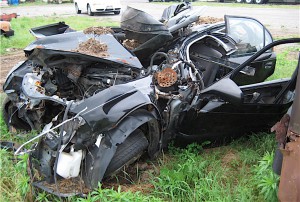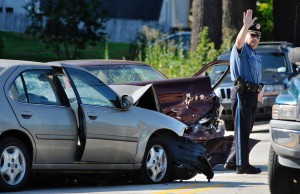
Traffic fatalities in the U.S. rose in 2016 compared with 2015 numbers. The second year in a row the number has spiked.
More Americans died on U.S. roadways last year than in 2015 and the numbers hit a nine-year high, according to the National Highway Traffic Safety Administration.
Car accidents claimed the lives of 37,461 people in 2016, up 5.6% from the previous year. The agency pointed to the usual reasons for the fatalities: speeding and failing to wear seat belts. NHTSA also tagged the increase to a 5.1% jump in motorcycle deaths.
The increase is the second year in a row that deaths have ticked upward. Prior to that, they had decreased six out of seven years between 2007 and 2014. The lowest tally recorded was 32,744 in 2014. The last year in which crash deaths were higher was 2007, when 41,259 were killed.
The long-term decrease is tied to improved design efforts as well an increase in safety technology in vehicles, such as anti-lock brakes. However, distracted driving habits, such as texting while driving, have offset the benefits of new technology, although distracted driving deaths fell 2.2% to 3,450, NHTSA reported.
(Click Here for details about pedestrian deaths reaching a new high in 2016.)
The increase in deaths in 2016 was largely attributable to other mistakes by drivers and passengers, including a 4% increase in speeding deaths and a 4.6% increase in fatalities due to unbelted passengers. There was also a 9% jump in pedestrian deaths, and drunken driving deaths rose 1.7%.
NHTSA said it “continues to work closely with its state and local partners, law enforcement agencies” and others “to help address the human choices” that are blamed for 94% of serious crashes.
The agency also noted it also continues to promote vehicle technologies that hold the potential to reduce the number of crashes and save thousands of lives every year, and may eventually help reduce or eliminate human error and the mistakes that drivers make behind the wheel.
Fortunately, there is plenty of technology designed to help with those issues. Automatic emergency braking, rearview cameras, lane departure warning and advanced air bags have helped improve car safety.
(Click Here for more about the impact of infotainment systems on distracted driving.)
Some observers are pointing to a new source of distraction in vehicles beyond phones, such the ever-increasingly complicated infotainment systems dominating the new vehicle scene. The AAA Foundation for Traffic Safety released a report suggesting that the latest infotainment systems in new vehicle promote distracted driving behaviors and on a scale greater than cell phones.
Deaths involving distracted driving jumped 8.8% to 3,477 in 2015, the latest year in which statistics were available, according to the National Highway Traffic Safety Administration.
“Some in-vehicle technology can create unsafe situations for drivers on the road by increasing the time they spend with their eyes and attention off the road and hands off the wheel,” said Dr. David Yang, executive director of the AAA Foundation for Traffic Safety.
“When an in-vehicle technology is not properly designed, simple tasks for drivers can become complicated and require more effort from drivers to complete.”
(New vehicles costing Americans an extra $706 each month. Find out more, Click Here.)
In AAA’s study, which included 30 infotainment systems tested by University of Utah researchers, distraction was “very high” on 12 of systems, “high” on 11 and “moderate” on seven. None of the systems generated “low” distraction, according to the researchers.


How good of a job are police doing of capturing whether distracted driving is a factor in accidents? The last I heard is that it isn’t even considered in some states.
I suspect that if we had more data, we’d see that distracted driving is even more significant as a cause of crashes.
Texting is not just a “teen” problem. There are millions of employees who seek to do work while behind the wheel. Fleet vehicles/company cars are on the road more than teen drivers. They “multi-task” becoming very distracted.
The State wants to increase fees and fines, but there is a tech way to stop these distraction. There are apps to block you using your phone when you drive. AT&T DriveMode is one example and it is FREE!
One area that is rarely discussed is that each state has hundreds of State vehicles that inspectors, regulators and the agricultural department use as fleet vehicles, but they do not have the technology to diminish distracted driving. I would love to see one state lead by example and use a program, like FleetMode, to block texts, redirect incoming phone calls, and impede all other apps in the State vehicles. If we want our state roads to be safer, let’s start by making our state vehicles safer.